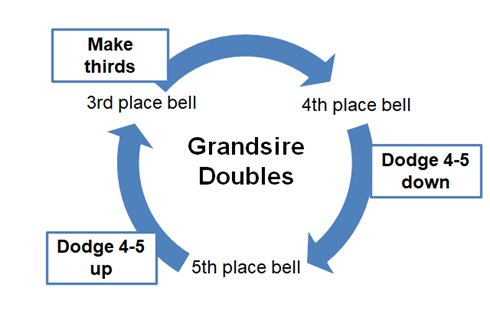Method Toolboxes for ringers
9. Grandsire Doubles Toolbox
9.1. The plain course explained
 Method structure
Method structure
The blue line of Grandsire Doubles is shown on the right, with the treble coloured red and the second coloured blue.
Grandsire Doubles is a twin hunt method. In the plain course, the treble and 2 both plain hunt. Apart from the treble, the other bell plain hunting is known as the hunt bell. In a plain course, only the 3, 4, and 5 are working bells. At only 30 changes long, the plain course comes back into rounds quite quickly.
The treble and 2 plain hunt. Bells 3, 4 and 5 ring a cycle of work: dodge 4-5 down, dodge 4-5 up, make thirds.

Starts
Grandsire starts are more complicated that Plain Bob starts.
- The hunt bell (2) leads.
- The third (3) strikes one blow in thirds and then hunts down to the front.
- The fourth and fifth (4 and 5) complete the dodge and then hunt.
Treble signposts
When ringing Grandsire Doubles, treble signposts are particularly useful.
- If the treble takes your bell off lead, make two blows in thirds place and
return to lead. - If your bell passes the treble in 2-3, dodge 4-5 up.
- If your bell passes the treble in 3-4, dodge 4-5 down.
- If your bell passes the treble in 4-5, you are the hunt bell.
Tip
After your bell has passed the treble, the next bell you pass is always the hunt bell.
Cribsheet
Download the Grandsire Doubles cribsheet for further study or for use in the tower.